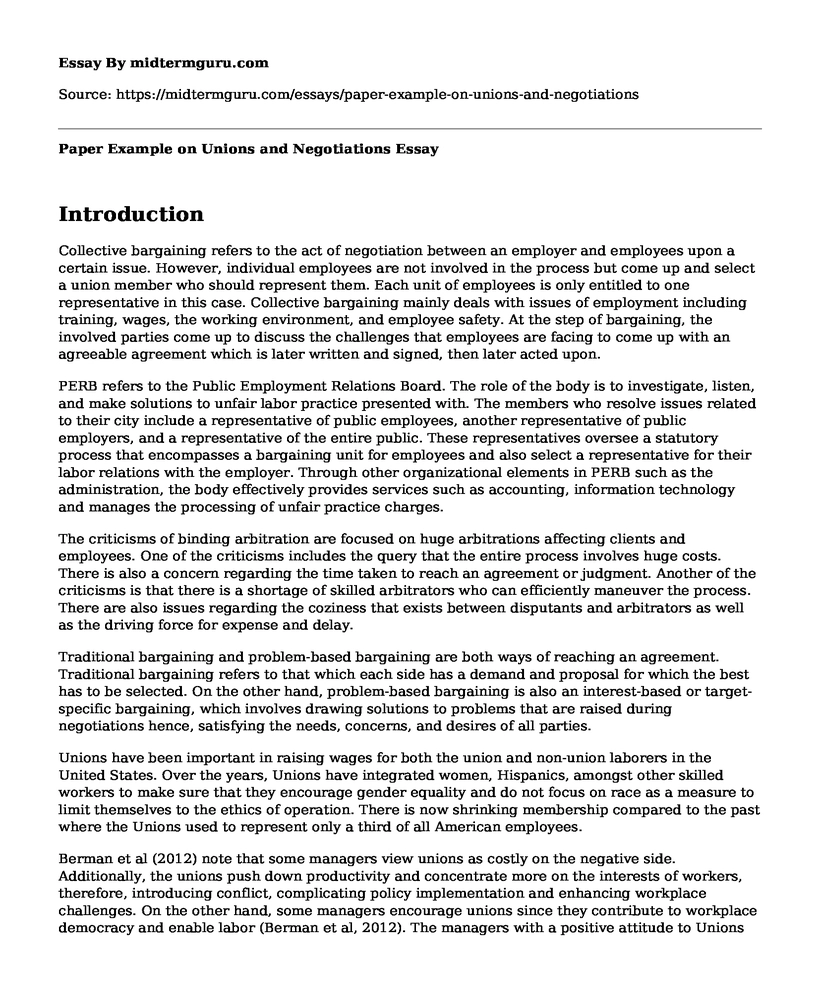Introduction
Collective bargaining refers to the act of negotiation between an employer and employees upon a certain issue. However, individual employees are not involved in the process but come up and select a union member who should represent them. Each unit of employees is only entitled to one representative in this case. Collective bargaining mainly deals with issues of employment including training, wages, the working environment, and employee safety. At the step of bargaining, the involved parties come up to discuss the challenges that employees are facing to come up with an agreeable agreement which is later written and signed, then later acted upon.
PERB refers to the Public Employment Relations Board. The role of the body is to investigate, listen, and make solutions to unfair labor practice presented with. The members who resolve issues related to their city include a representative of public employees, another representative of public employers, and a representative of the entire public. These representatives oversee a statutory process that encompasses a bargaining unit for employees and also select a representative for their labor relations with the employer. Through other organizational elements in PERB such as the administration, the body effectively provides services such as accounting, information technology and manages the processing of unfair practice charges.
The criticisms of binding arbitration are focused on huge arbitrations affecting clients and employees. One of the criticisms includes the query that the entire process involves huge costs. There is also a concern regarding the time taken to reach an agreement or judgment. Another of the criticisms is that there is a shortage of skilled arbitrators who can efficiently maneuver the process. There are also issues regarding the coziness that exists between disputants and arbitrators as well as the driving force for expense and delay.
Traditional bargaining and problem-based bargaining are both ways of reaching an agreement. Traditional bargaining refers to that which each side has a demand and proposal for which the best has to be selected. On the other hand, problem-based bargaining is also an interest-based or target-specific bargaining, which involves drawing solutions to problems that are raised during negotiations hence, satisfying the needs, concerns, and desires of all parties.
Unions have been important in raising wages for both the union and non-union laborers in the United States. Over the years, Unions have integrated women, Hispanics, amongst other skilled workers to make sure that they encourage gender equality and do not focus on race as a measure to limit themselves to the ethics of operation. There is now shrinking membership compared to the past where the Unions used to represent only a third of all American employees.
Berman et al (2012) note that some managers view unions as costly on the negative side. Additionally, the unions push down productivity and concentrate more on the interests of workers, therefore, introducing conflict, complicating policy implementation and enhancing workplace challenges. On the other hand, some managers encourage unions since they contribute to workplace democracy and enable labor (Berman et al, 2012). The managers with a positive attitude to Unions cling to them as they improve the employment conditions.
The rate of Union membership in the public sector stands at 34.4% whereas that of the private sector stands at 6.5% (US Department of Labor, 2018). The numbers belonging to a union in the public sector were recorded as 7.2 million employees with that of the private sector being recorded as 7.6 million workers by the Bureau of labor statistics from the United States Department of Labor in 2017 (US Department of Labor, 2018).
References
Berman, et al. (2012). Human resource management in public service: Paradoxes, processes, and problems. Thousand Oaks, CA: Sage Publications.
US Department of Labor. (2018, January 19). Union Members Summary. Retrieved from https://www.bls.gov/news.release/union2.nr0.htm
Cite this page
Paper Example on Unions and Negotiations. (2022, Sep 07). Retrieved from https://midtermguru.com/essays/paper-example-on-unions-and-negotiations
If you are the original author of this essay and no longer wish to have it published on the midtermguru.com website, please click below to request its removal:
- Essay on Global Leadership and Management Issues in the 21st Century
- Paper Example About Meaningful Executive Summary
- Essay on What Makes for Good Leadership
- Paper Example on Abilene Paradox and Group Think
- Essay Sample on Understanding Someone Else's Perspective
- Stock-Out: A Major Challenge for Tea Company T2 - Essay Sample
- Strategic Plan: Scottsdale Police Department 2021-2024 - Essay Sample







